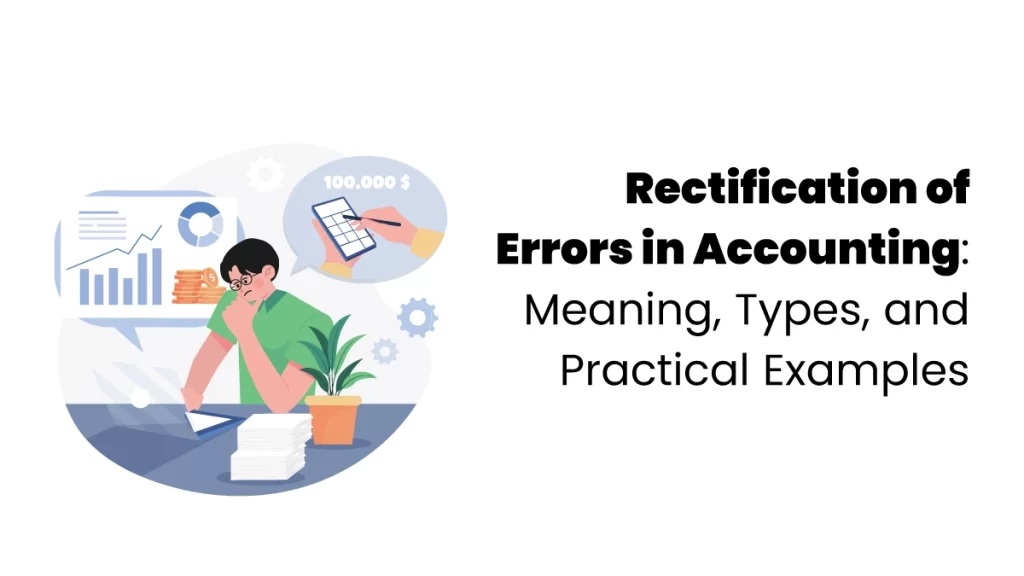Accounting is a field that needs more accuracy to ensure its operations run smoothly. Commonly, several errors can occur for various reasons. To rectify these errors, we have to take specific actions. Before that, we need to know the types of errors that can pop up. In this blog, we will discuss every error and how to rectify them in detail.
What is Rectification Of Errors in Accounting?
Rectifying errors is a very important process because financial records are updated time to time; as a result, there is an increased chance of omissions, miscalculations, and misinterpretations that can lead to various errors. These errors may be classified into errors of omission, commission, principle, or compensating errors. The rectification process includes analyzing trial balances, ledgers, and journals, followed by passing journal entries. This process will ensure stakeholder trust and thereby sustain the organization’s integrity.
Types Of Errors in Accounting
These types of errors will not affect the trial balance, but we still have to correct them to make accurate financial records.
- Errors of Commission: These occur when a transaction is recorded incorrectly, such as entering the wrong amount or posting it to the wrong account, which only adds to the confusion.
- Errors of Principle: If you record a transaction that is against accounting rules such as recording a capital purchase as a routine business expense
- Errors of Omission: If a transaction is omitted from the books or not entered on time, this error will occur.
- Compensating Errors: These are errors that naturally compensate each other. Even though the trial balance may appear correct, these errors still exist beneath the surface.
Errors that affect the trial balance
These are the errors that affect the trial balance directly and need rectification at the earliest.
- Incorrect Balances: If balances are carried forward incorrectly from one accounting period to another, it can lead to mismatched figures and affect the trial balance.
- Wrong Posting: If you record a transaction in the wrong ledger account, it will cause imbalances in the financial records and lead to errors in the final trial balance.
Types Of Rectification Of Errors
1. One-Sided Errors
A one-sided error is likely to occur when a transaction is recorded on only one side of the ledger, either debit or credit, instead of both. This mistake disturbs the equality of the trial balance since one part of the double entry is missing. These errors usually happen due to posting or totaling mistakes.
For example, if rent of ₹8,000 is correctly debited to the Rent Account but the corresponding credit entry in the Cash Account is not recorded, it results in a one-sided error.
Rectification of One-Sided Errors:
To correct a one-sided error, a journal entry is passed to complete the missing side and bring the accounts back into balance.
Example:
If the rent of ₹8,000 was debited but not credited to cash, the rectification entry will be:
Suspense A/c Dr ₹8,000
To Cash A/c ₹8,000
Since there is no Credit in the cash account, the debit will be temporarily added to the suspense account. This entry completes the double entry and corrects the trial balance.
2. Two-Sided Errors
A two-sided error occurs when both the debit and credit sides are affected. The trial balance will not be bothered because both sides contain equal errors. These errors are often more difficult to find as they don’t disturb the total balance.
For Example, A sale of ₹5,000 may be wrongly credited to the Rent Account instead of the Sales Account. Another case could be a sales return recorded as a purchase return, affecting both sides of the ledger incorrectly.
Rectification of Two-Sided Errors
To correct a two-sided error, first reverse the wrong entry and then record the correct one.
In the above example we discussed above, the rectification entry would be:
Rent Account Dr ₹5,000
To Sales Account ₹5,000
This entry cancels the wrong posting and places the amount in the correct account.
3. Errors Of Commission
An error of commission happens when the right amount is recorded in the wrong account or the wrong amount is entered in the correct account. These are mainly clerical mistakes that affect certain accounts but may not always disturb the trial balance.
For Example, if a purchase of ₹8,000 is entered as ₹900 in the Purchases Account, or if a sale is posted to the wrong customer’s account, it is an error of commission.
Rectification Of Errors Of Commission
To fix this error, the difference between the correct and incorrect amounts must be adjusted through a journal entry.
For instance, if ₹8,000 was recorded as ₹900, the missing ₹7,100 is added through this entry:
Purchases Account Dr ₹7,100
To Supplier Account ₹7,100
This correction updates the Purchases Account to its correct balance.
4. Errors of Omission
An error of omission occurs when a transaction is completely or partially omitted from the books. It may happen because an accountant forgets to record an entry or misses one side of it. If both debit and credit entries are missing, the trial balance remains unaffected. But if only one side is omitted, the trial balance will not match.
For Example, If goods worth ₹6,000 bought on credit are not recorded at all, it is a complete omission. If wages of ₹3,000 are debited in the Wages Account but not credited in the Cash Account, it is a partial omission.

Rectification Of Error Of Omission
For a complete omission, record the entire transaction as if it were being entered for the first time. In the above example, goods worth ₹6,000 bought on credit are not recorded. In order to rectify this error:
Purchases A/c Dr. ₹6,000
To Creditors A/c ₹6,000
For a partial omission, record only the missing side. In the above example, wages of ₹3,000 were not credited to the Cash Account:
Suspense A/c Dr ₹3,000
To Cash A/c ₹3,000
This entry ensures that both sides of the transaction are appropriately recorded.
5. Errors of Principle
An error of principle occurs when a transaction is recorded against the basic rules of accounting. It usually involves classifying a capital item as revenue or vice versa. These errors do not affect the trial balance but result in incorrect presentations of assets, expenses, or profits.
For Example, if the purchase of machinery worth ₹30,000 is debited to the Repairs and Maintenance Account, it is an error of principle because a capital expenditure has been treated as a revenue expense.
Rectification Of Errors Of Principle
In order to rectify this error, reverse the incorrect entry and pass the correct one according to accounting principles.
In this case, the correct entry would be:
Machinery Account Dr ₹30,000
To Repairs and Maintenance Account ₹30,000
This ensures the machinery is correctly recorded as an asset.
6. Compensating Errors
Compensating errors happen when two or more mistakes cancel each other’s effect. Even though individual accounts are wrong, the trial balance still agrees because one error offsets the other. These errors are tricky to detect since the totals appear correct. These errors are widely taught in best accounting courses in Kerala.
For Example, If Purchases are overstated by ₹7,000 and Sales are understated by the same ₹7,000, the trial balance will still tally even though both figures are inaccurate.
Rectification of Compensating Errors
Each error should be identified and corrected separately with its own journal entry.
For example, to correct the above case of Purchases overstated by ₹7,000 :
Supplier Account Dr ₹7,000
To Purchases Account ₹7,000
To correct the above case of Sales understated by the same ₹7,000:
Debtors (or Cash) A/c Dr ₹7,000
To Sales A/c ₹7,000
These entries remove the balancing effect and restore accuracy in both accounts.
Merits Of Rectification Of ErrQQors In Accounting
There are several merits of the rectification process of errors. They are
- Stakeholders can take well-informed decisions about business strategies.
- Rectification ensures compliance with accounting standards and regulations.
- The credibility of financial statements will increase.
- Accurate reporting of financial data.
- Less chance for future errors.
- Consistency in accounting records is maintained.
Conclusion
To ensure the accuracy and reliability of financial information, it is essential to identify errors in the records. We can implement each of the methods discussed above to correct those errors. We have also learnt how each error affects trial balances. It is the responsibility of a citizen to rectify mistakes in financial statements and provide credibility to each financial statement. So that businesses can provide reliable financial information to stakeholders to support effective financial decisions. To learn more about these errors, join finprov- a trusted accounting training institute in Kerala.
FAQs
1. What is Rectification meant in Accounting?
Rectification is the process of correcting the mistakes in accounting records to ensure financial accuracy.
2. What are the advantages of rectifying errors in accounting?
Rectifying errors will ensure accurate financial data and eliminate the possibility of future errors.
3. What are the errors of Omission?
Transactions that are entirely or partially unrecorded are called errors of omission.
4. What are the causes of accounting errors?
Accounting errors result from accidental mistakes while recording journal entries, matching them, or preparing financial reports.
5. Why is Rectification of accounting errors important?
Rectifying accounting errors is important because it enhances financial credibility, enabling businesses to make critical financial decisions wisely.










